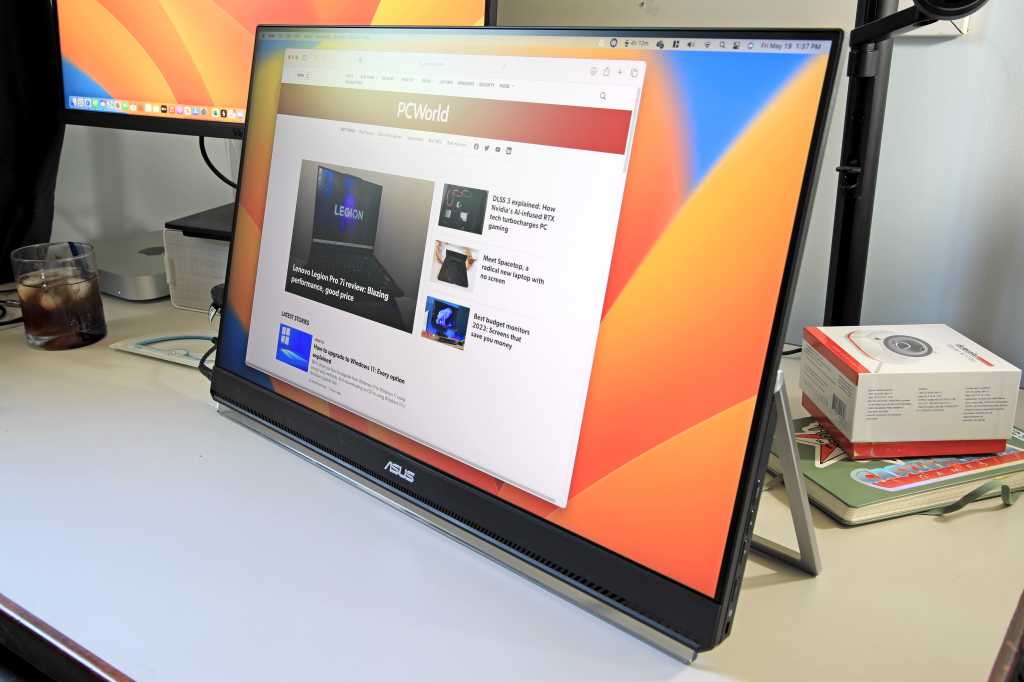Expert’s Rating
Pros
- Small, versatile desk stand with unique options
- Sturdy built-in kickstand for portable use
- Offers USB-C for easy single-cable connections
- Good image quality
Cons
- Lacks additional connection options
- Only 1080p resolution
- A bit pricey for its feature set
Our Verdict
The Asus ZenScreen MB249C’s unusual design doesn’t come cheap but provides genuinely useful versatility.
Price When Reviewed
$349.99
Best Prices Today: Asus ZenScreen MB249C
$349.00
Portable monitors are advertised for travel but, in reality, most never leave the home or office they’re shipped to. Many purchase portable monitors not for their portability but instead their versatility and ease of use. The Asus ZenScreen MB249C leans into this, offering unique benefits alongside a 24-inch screen.
Further reading: See our roundup of the best portable monitors to learn about competing products.
What are the Asus ZenScreen MB249C specs?
Asus ZenScreen MB249C is marketed as “portable” but has a 23.8-inch display. Clearly, portability in this case isn’t about sticking the monitor in a suitcase but instead refers to moving it across a home or corporate office.
- Display size: 23.8-inch widescreen
- Native resolution: 1920×1080
- Panel type: IPS LCD
- Refresh rate: 75Hz
- Adaptive Sync: Yes, AMD FreeSync
- HDR: None
- Ports: 1x USB-C with DisplayPort Alternate Mode and 60 watts Power Delivery, 1x HDMI 1.4, 1x 3.5mm audio out
- Stand adjustment: Height, swivel, tilt
- VESA mount: Yes, 100x100mm
- Speakers: Yes, 2x 1-watt
- Price: $349.99
The MB249C’s specifications are otherwise average for a 1080p office display. It does improve on the typical refresh rate of 60Hz, instead delivering up to 75Hz, and provides support for Adaptive Sync.
Asus ZenScreen MB249C design
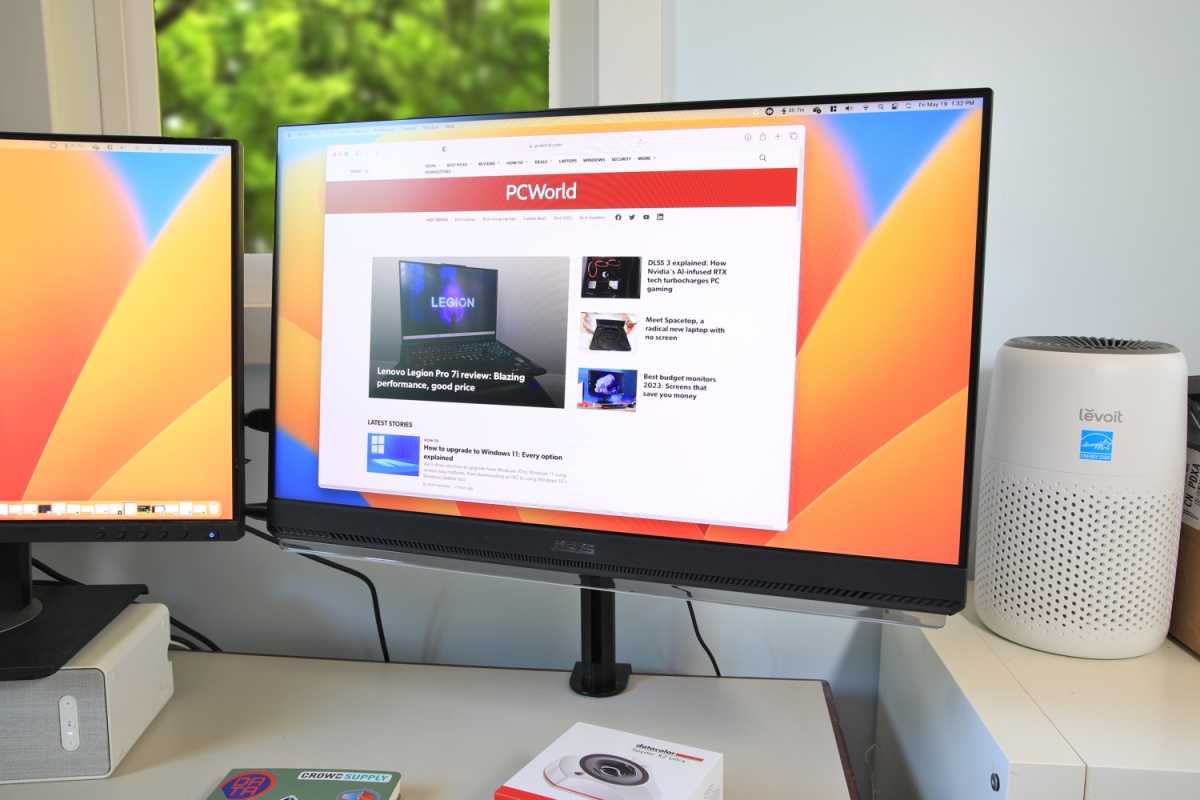
The Asus ZenScreen MB249C can be mounted on a desk or set up with its kickstand.
Matt Smith
Let’s talk about the elephant in the room. Asus’ ZenScreen MB249C is a portable monitor, yet it has a 24-inch display panel, measures 21 inches wide, and weighs over six pounds. So, what gives?
Asus imagines this monitor as a portable display for office and home office use. It may not be suited for travel, but there are still situations where it’s handy to move a display around a space. At home, it could let you have two home office setups without two monitors. In an office, it could be carried to meetings if you need to lead a presentation.

Asus’ ZenScreen MB249C comes with an attachable kickstand.
Matt Smith
The ZenScreen ships with a stand that clips to the back of a desk instead of sitting on top of it, which makes the ZenScreen MB249C easy to use as a second monitor in any home office setup. The stand is small, yet functional, supporting adjustment for height, tilt, and swivel. It also rotates 90 degrees into portrait orientation.
It also comes with two alternative options to the stand: a folding kickstand and an unusual hanger. The kickstand flips out from the rear of the display to support it, as true of most portable monitor kickstands. The hanger, which Asus calls a “partition mount,” is designed to hang from a half-height cubicle partition and effectively functions as a wall mount, placing the display flush with a cubicle wall. I don’t have a cubicle in my home office, so I wasn’t able to give this option a try.
The MB249C’s design is unusual but clever. It’s a niche, but one that many will appreciate.
Asus ZenScreen MB249C features and menus
The Asus ZenScreen MB249C offers advantages to those who want to tweak the monitor’s settings. It ships with a reasonably capable menu that includes a variety of image mode presets and control over aspects of image quality such as color temperature and skin tone. Interestingly, it also has a “Shadow Boost” which can be used in games to make enemies in dark areas easier to notice.
That’s not to say image quality adjustments are extensive. There’s no gamma adjustment and the color temperature adjustment is slim. Still, many portable monitors only offer brightness and contrast adjustment, so the MB249C is above average.
The MB249C’s design is unusual but clever. It’s a niche, but one that many will appreciate.
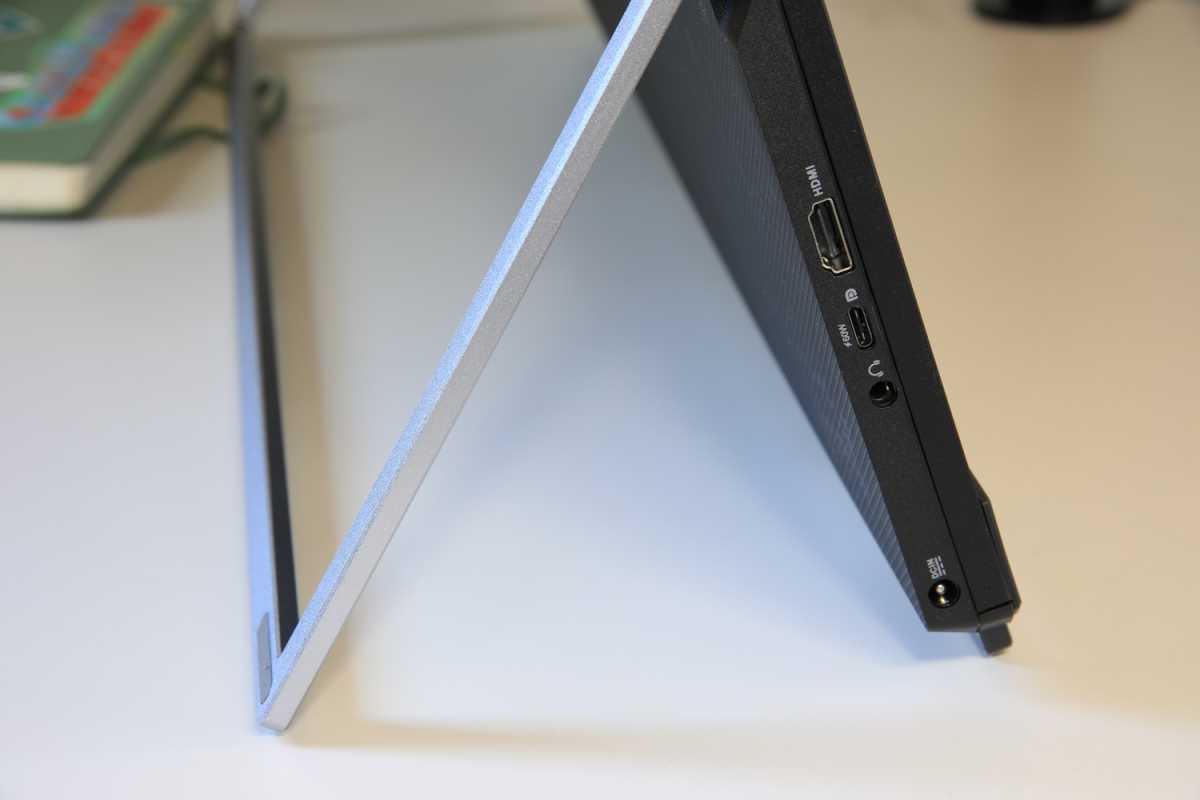
Asus ZenScreen MB249C connectivity and ports.
Matt Smith
Connectivity is more mundane. The monitor supports USB-C input through DisplayPort Alternate Mode alongside HDMI 1.4, but that’s it. Given the price, an additional video input would be appreciated. The monitor lacks USB-A, which feels like a missed opportunity—there’s room.
Those looking to connect over USB-C should note the monitor supports up to 60 watts of Power Delivery and, in my testing, will require that to operate solely over USB-C. The monitor will function with a USB-C laptop or desktop that lacks adequate USB Power Delivery when the monitor’s bundled power brick is connected. The power brick is also needed when only the HDMI video input is in use.
The monitor has built-in speakers, but you won’t want to rely on them. Volume is low and the speakers suffer distortion when playing music, movies, or anything more complicated than spoken dialogue and system messages. Weak speakers, though disappointing, are typical for an office monitor.
How is the Asus ZenScreen MB249C SDR image quality?
The Asus ZenScreen MB249C targets office productivity and makes few specific claims about its image quality. That left me with low expectations, which, to my surprise, the monitor easily beat.
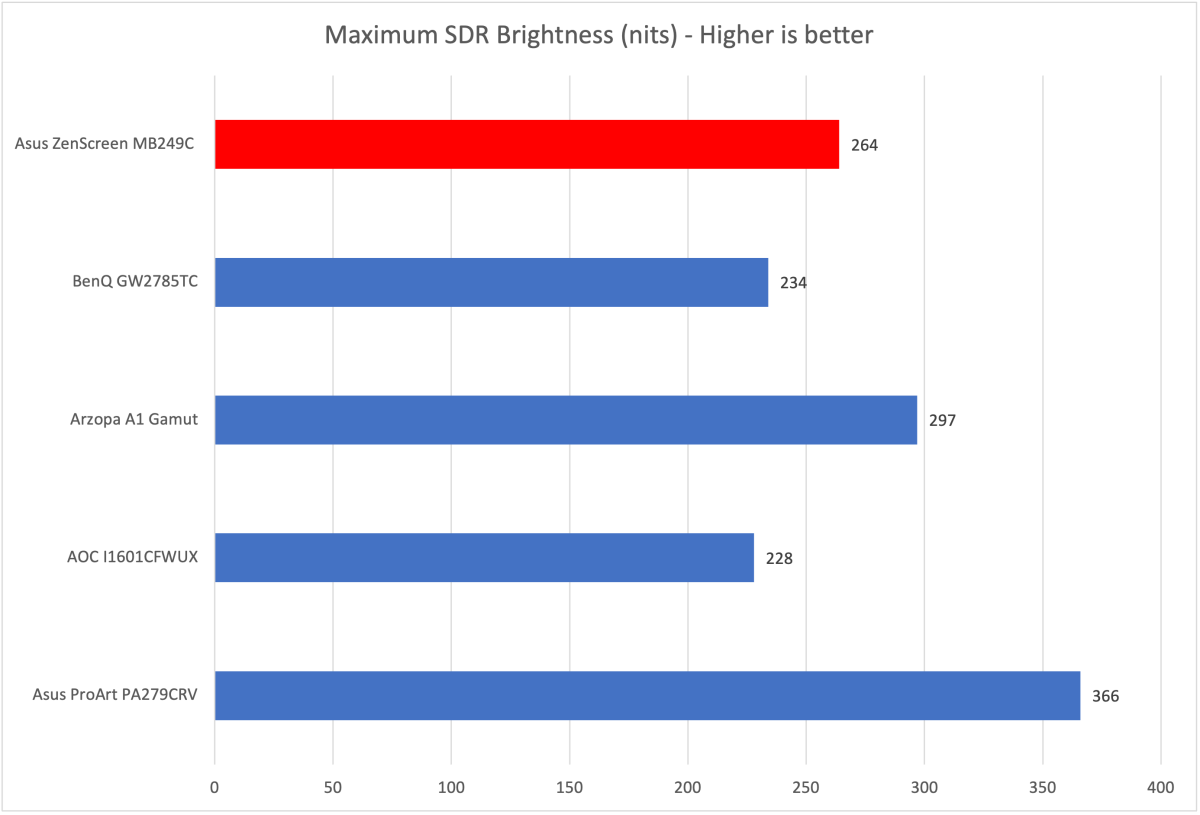
Matt Smith
Brightness comes in at a respectable 264 nits which, although not amazing, is mid-pack for a portable monitor and quite good for an office productivity monitor. This level of brightness is sufficient for use in any room with moderate light control. It may appear a bit dim near a sunlit window, however.
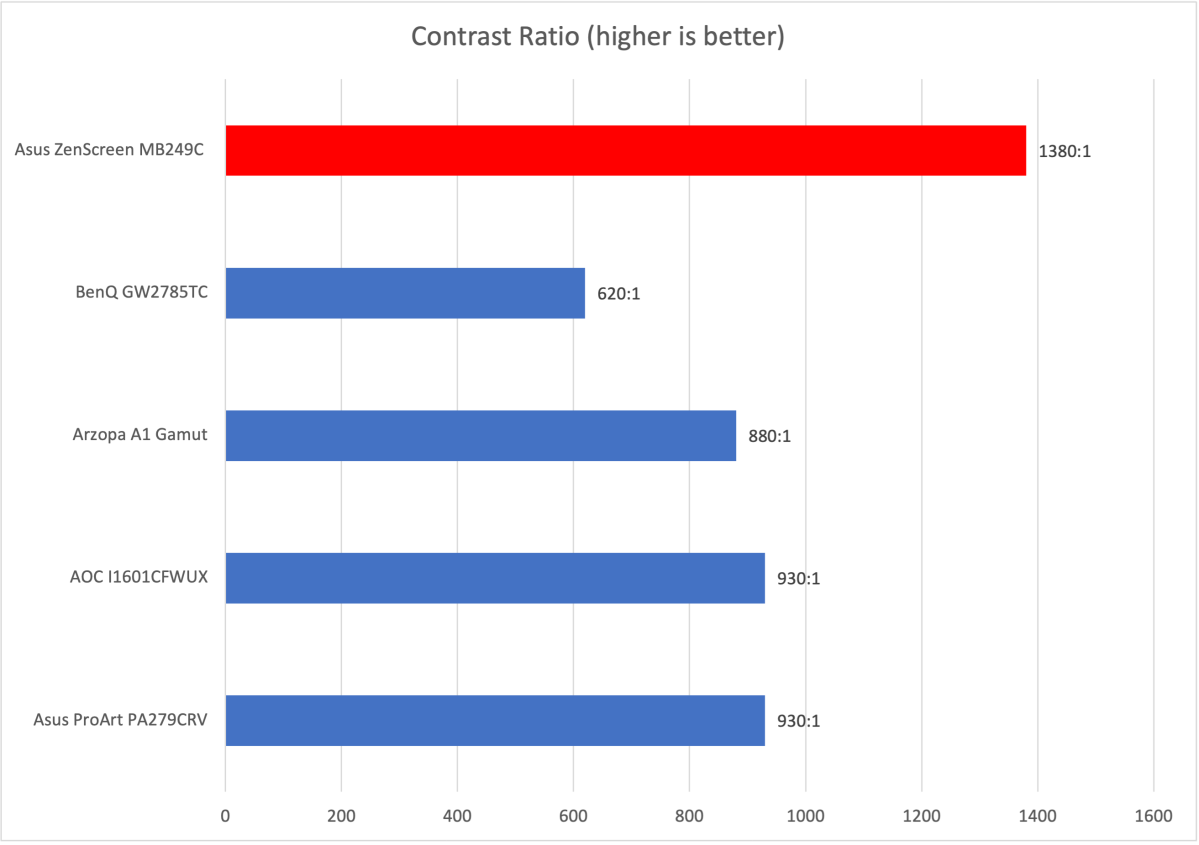
Matt Smith
The monitor delivered a surprise in contrast with a maximum contrast ratio of 1380:1. That’s towards the high end of what I expect from monitors with an IPS display panel and no advanced backlight technology, such as Mini-LED.
Don’t get too excited. The monitor can still struggle with shadow detail, especially when viewing movies that have a dark palette like The Batman. Still, a contrast ratio of 1380:1 is higher than most competitors and it provides a better sense of depth. An alternative like the BenQ GW2785TC will appear flat and one-dimensional by comparison.
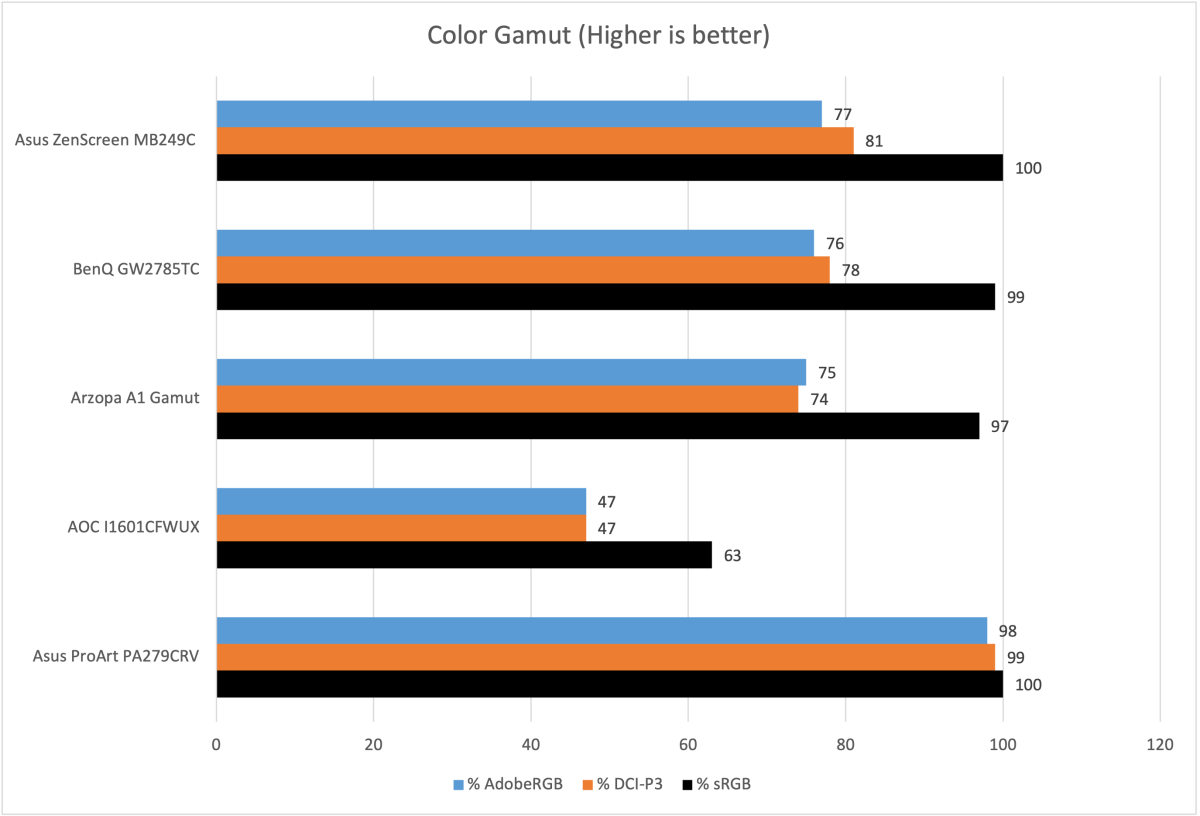
Matt Smith
Color gamut isn’t bad, either, providing 100 percent of the sRGB color gamut and 81 percent of DCI-P3. This isn’t enough to be considered a “wide gamut” monitor, and not enough for many content creators looking to edit photos or video, but it’s a few percent better than most alternatives. The monitor has enjoyable, vibrant color.
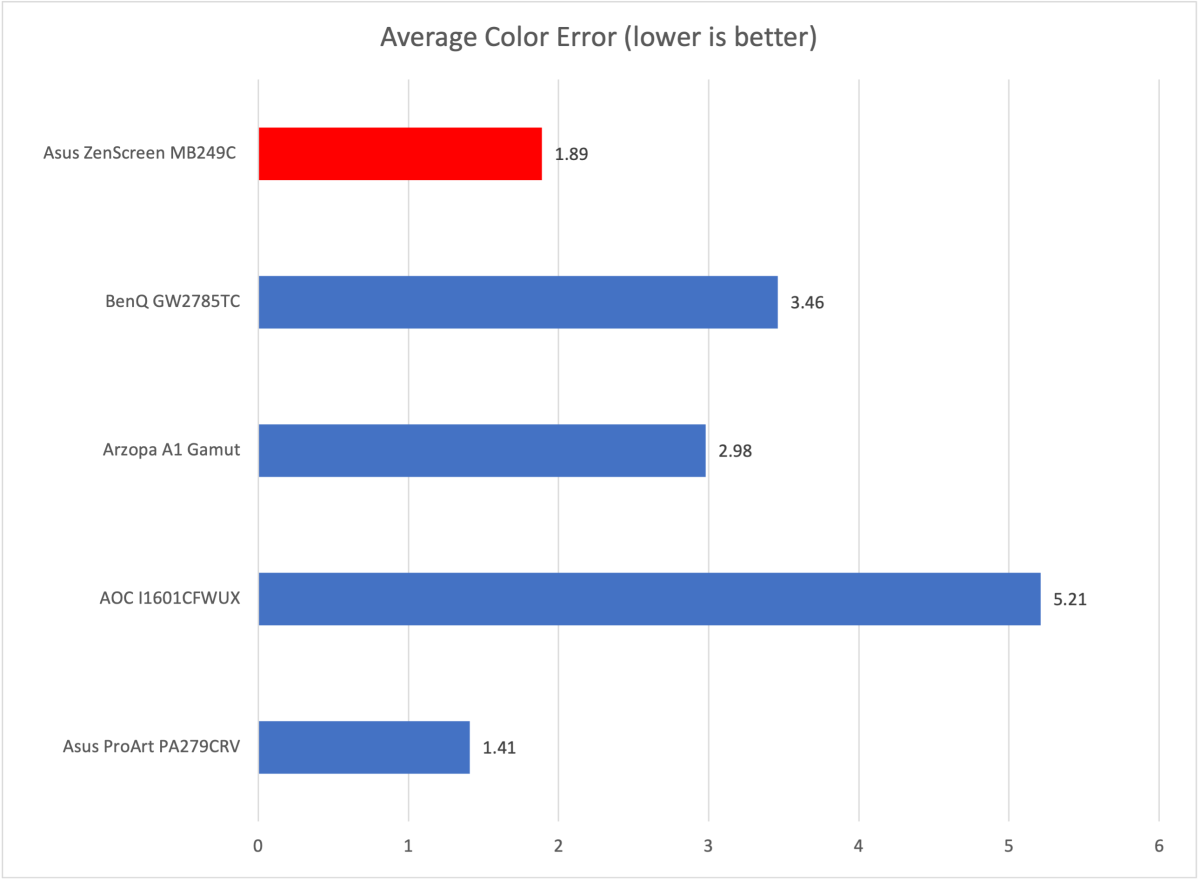
Matt Smith
It’s accurate, as well, achieving an average color error that’s just a tad worse than the Asus ProArt PA279CRV, a monitor specifically built for accurate and realistic color performance. The color error is worst in blue hues, which is often true of LED-backlit monitors, but it didn’t jump out in real-world use.
The monitor’s accuracy is further helped by a gamma reading of 2.1, which means that images appear just slightly brighter than they should. Color temperature came in at precisely the preferred target of 6500K, so it’s neither overly warm or too cool. To put it simply, the monitor appears extremely accurate in real-world use and is well suited to office productivity.
Sharpness is a downside, as the display provides only 1080p resolution with a pixel density of roughly 93 pixels per inch. Many office monitors in this price range can hit 4K resolution, which increase pixel density to 163 pixels per inch. It’s a noticeable gap and the Asus ZenScreen MB249C can look pixelated and soft next to 4K alternatives.
On the whole, Asus’ ZenScreen MB249C provides excellent image quality for its intended purpose. It’s bright enough and scores well in contrast, color gamut, and color accuracy, all while avoiding notable problems or pitfalls. The only caveat is resolution, as it’s possible to buy a similar 4K such as the Dell S2721QS for less—however, such alternatives lack the MB249C’s portability.
Asus ZenScreen MB249C HDR image quality
The Asus ZenScreen MB249C doesn’t support HDR. That’s to be expected, as the monitor’s maximum brightness is well below what’s needed for a passable HDR experience. Increasing brightness to levels suitable for HDR also increases power draw, which wouldn’t pair well with the monitor’s USB-C connectivity.
Asus ZenScreen MB249C motion performance
Though meant for productivity, the Asus ZenScreen MB249C offers a slightly improved refresh rate of 75Hz and Adaptive Sync support for smooth frame pacing in games. Adaptive Sync was functional with the monitor connected to an AMD video card. I wasn’t able to test the monitor with Nvidia G-Sync.
Is the Asus ZenScreen MB249c worth it?
The Asus ZenScreen MB249C is an unusual but useful home and office productivity monitor. Its odd design, which pairs a 24-inch screen with several stand options including a kickstand, makes it easy to tote around a house or corporate office. It also provides good image quality with adequate brightness and strong color performance. The $350 price is a bit much for a 1080p monitor and won’t make sense if you have no reason to use its unique features, but it’s not unreasonable. The MB249C is a great choice for a second monitor, too, as it offers multiple ways to mount and orient it alongside your primary monitor.

